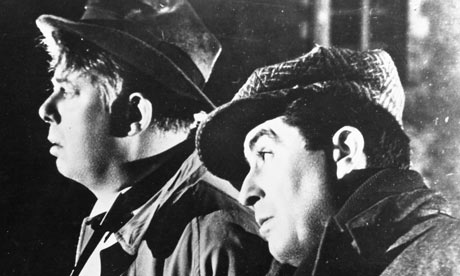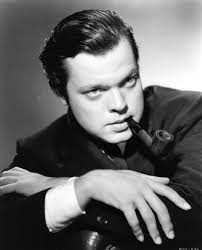'What interests me in the cinema is abstraction.' - Orson Welles
One cannot help noticing that something is happening in the cinema
at the moment. Our sensibilities have been in danger of getting
blunted by those everyday films which, year in year out, show their
tired and conventional faces to the world.
 |
Jean Renoir and Julien Carette in "La Regle du Jeu", 1939 |
The cinema of today is getting a new face. How can one tell?
Simply by using one's eyes. Only a film critic could fail to notice the
striking facial transformation which is taking place before our very
eyes. In which films can this new beauty be found? Precisely those
which have been ignored by the critics. It is not just a coincidence
that Renoir's La Regle du Jeu, Welles's films, and Bresson's Les
Dames du Bois de Boulogne, all films which establish the foundations
of a new future for the cinema, have escaped the attention of critics,
who in any case were not capable of spotting them.
But it is significant that the films which fail to obtain the blessing
of the critics are precisely those which myself and several of my
friends all agree about. We see in them, if you like, something of the
prophetic. That's why I am talking about avant-garde. There is
always an avant-garde when something new takes place... .
To come to the point: the cinema is quite simply becoming a
means of expression, just as all the other arts have been before it,
and in particular painting and the novel. After having been successively
a fairground attraction, an amusement analogous to boulevard
theatre, or a means of preserving the images of an era, it is gradually
becoming a language. By language, I mean a form in which and by
which an artist can express his thoughts, however abstract they may
be, or translate his obsessions exactly as he does in the contemporary
essay or novel. That is why I would like to call this new age
of cinema the age of camera-stylo (camera-pen). This metaphor has
a very precise sense. By it I mean that the cinema will gradually
break free from the tyranny of what is visual, from the image for its
own sake, from the immediate and concrete demands of the narrative,
to become a means of writing just as flexible and subtle as
written language. This art, although blessed with an enormous
potential, is an easy prey to prejudice; it cannot go on for ever
ploughing the same field of realism and social fantasy which has
been bequeathed to it by the popular novel. It can tackle any subject, any genre. The most philosophical meditations on human
production, psychology, metaphysics, ideas, and passions lie well
within its province. I will even go so far as to say that contemporary
ideas and philosophies of life are such that only the cinema can do
justice to them. Maurice Nadeau wrote in an article in the newspaper
Combat: 'If Descartes lived today, he would write novels.'
With all due respect to Nadeau, a Descartes of today would already
have shut himself up in his bedroom with a 16mm camera and some
film, and would be writing his philosophy on film: for his Discours
de la Methods would today be of such a kind that only the cinema
could express it satisfactorily.
It must be understood that up to now the cinema has been
nothing more than a show. This is due to the basic fact that all films
are projected in an auditorium. But with the development of 16mm
and television, the day is not far off when everyone will possess a
projector, will go to the local bookstore and hire films written on
any subject, of any form, from literary criticism and novels to
mathematics, history, and general science. From that moment on,
it will no longer be possible to speak of the cinema. There will be
several cinemas just as today there are several literatures, for the
cinema, like literature, is not so much a particular art as a language
which can express any sphere of thought.
 |
Sergei Eisenstein |
This idea of the cinema expressing ideas is not perhaps a new one.
Feyder has said: 'I could make a film with Montesquieu's L''Esprit
des Lois.' But Feyder was thinking of illustrating it 'with pictures'
just as Eisenstein had thought of illustrating Marx's Capital in book
fashion. What I am trying to say is that the cinema is now moving
towards a form which is making it such a precise language that it
will soon be possible to write ideas directly on film without even
having to resort to those heavy associations of images that were the
delight of the silent cinema. In other words, in order to suggest the
passing of time, there is no need to show falling leaves and then
apple trees in blossom; and in order to suggest that a hero wants to
make love there are surely other ways of going about it than showing
a saucepan of milk boiling over on to the stove, as Henri-Georges Clouzot does in Quai des Orfevres (Jenny Lamour).
The fundamental problem of the cinema is how to express
thought. The creation of this language has preoccupied all the
theoreticians and writers in the history of the cinema, from Eisenstein
down to the scriptwriters and adaptors of the sound cinema.
But neither the silent cinema, because it was the slave of a static
conception of the image, nor the classical sound cinema, as it has
existed right up to now, has been able to solve this problem satisfactorily.
The silent cinema thought it could get out of it through
editing and the juxtaposition of images. Remember Eisenstein's
famous statement: 'Editing is for me the means of giving movement
(i.e. an idea) to two static images.' And when sound came, he was
content to adapt theatrical devices.
 |
André Malraux |
One of the fundamental phenomena of the last few years has been
the growing realisation of the dynamic, i.e. significant, character of
the cinematic image. Every film, because its primary function is to
move, i.e. to take place in time, is a theorem. It is a series of images
which, from one end to the other, have an inexorable logic (or
better even, a dialectic) of their own. We have come to realise that
the meaning which the silent cinema tried to give birth to through
symbolic association exists within the image itself, in the development
of the narrative, in every gesture of the characters, in every
line of dialogue, in those camera movements which relate objects to
objects and characters to objects. All thought, like all feeling, is a
relationship between one human being and another human being
or certain objects which form part of his universe. It is by clarifying
these relationships, by making a tangible allusion, that the cinema
can really make itself the vehicle of thought. From today onwards,
it will be possible for the cinema to produce works which are
equivalent, in their profundity and meaning, to the novels of
Faulkner and Malraux, to the essays of Sartre and Camus. Moreover
we already have a significant example: Malraux's L'Espoir, the
film which he directed from his own novel, in which, perhaps for the
first time ever, film language is the exact equivalent of literary
language.
Let us now have a look at the way people make concessions to the
supposed (but fallacious) requirements of the cinema. Scriptwriters
who adapt Balzac or Dostoievsky excuse the idiotic transformations
they impose on the works from which they construct
their scenarios by pleading that the cinema is incapable of rendering
every psychological or metaphysical overtone. In their hands,
Balzac becomes a collection of engravings in which fashion has the
most important place, and Dostoievsky suddenly begins to resemble
the novels of Joseph Kessel, with Russian-style drinking-bouts in
night-clubs and troika races in the snow. Well, the only cause of
these compressions is laziness and lack of imagination. The cinema
of today is capable of expressing any kind of reality. What interests
us is the creation of this new language. We have no desire to rehash
those poetic documentaries and surrealist films of twenty-five years
ago every time we manage to escape the demands of a commercial
industry. Let's face it: between the pure cinema of the 1920s and
filmed theatre, there is plenty of room for a different and individual
kind of film-making.
 |
The young Orson Welles. |
This of course implies that the scriptwriter directs his own
scripts; or rather, that the scriptwriter ceases to exist, for in this kind
of film-making the distinction between author and director loses
all meaning. Direction is no longer a means of illustrating or presenting
a scene, but a true act of writing. The film-maker/author
writes with his camera as a writer writes with his pen. In an art in
which a length of film and sound-track is put in motion and proceeds,
by means of a certain form and a certain story (there can even
be no story at all - it matters little), to evolve a philosophy of life,
how can one possibly distinguish between the man who conceives
the work and the man who writes it? Could one imagine a Faulkner
novel written by someone other than Faulkner? And would Citizen
Kane be satisfactory in any other form than that given to it by
Orson Welles?
Let me say once again that I realise the term avant-garde savours
of the surrealist and so-called abstract films of the 1920s. But that
avant-garde is already old hat. It was trying to create a specific
domain for the cinema; we on the contrary are seeking to broaden
it and make it the most extensive and clearest language there
is. Problems such as the translation into cinematic terms of
verbal tenses and logical relationships interest us much more
than the creation of the exclusively visual and static art dreamt
of by the surrealists. In any case, they were doing no more than
make cinematic adaptations of their experiments in painting
and poetry.
So there we are. This has nothing to do with a school, or even a
movement. Perhaps it could simply be called a tendency: a new
awareness, a desire to transform the cinema and hasten the advent
of an exciting future. Of course, no tendency can be so called unless
it has something concrete to show for itself. The films will come,
they will see the light of day - make no mistake about it. The
economic and material difficulties of the cinema create the strange
paradox whereby one can talk about something which does not yet
exist; for although we know what we want, we do not know whether,
when, and how we will be able to do it. But the cinema cannot but
develop. It is an art that cannot live by looking back over the past
and chewing over the nostalgic memories of an age gone by.
Already it is looking to the future, for the future, in the cinema as
elsewhere, is the only thing that matters.